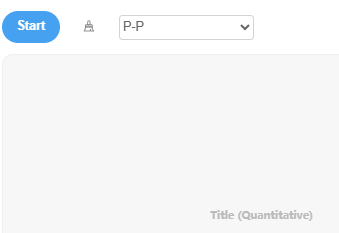Probability-Probability (P-P) / Quantile-Quantile (Q-Q)
Probability-Probability (P-P) / Quantile-Quantile (Q-Q) is commonly used to visually assess whether data follow a specific distribution. In SPSSAU, the default is to check for normality. SPSSAU supports:
Batch generation of P-P or Q-Q for selected 'titles'.
P-P plot is generated by default, with Q-Q as an option.
Currently, SPSSAU only supports the normal distribution.

Q-Q Calculation Steps
P-P compares the cumulative probability of the sample data with the cumulative probability of the theoretical normal distribution. Specifically:
Sample Cumulative Probability
For sample data X1, X2, ..., Xn, sort the data in ascending order as X(1), X(2), ..., X(n) and calculate the cumulative probability for each sample point:
Theoretical Normal Distribution Cumulative Probability
Assuming the sample data follow a normal distribution, calculate the corresponding theoretical cumulative probability:
Φ is the cumulative distribution function of the standard normal distribution.
Plotting P-P
In P-P, the X-axis represents P(X ≤ X(i)), and the Y-axis represents F(X(i)). If the sample data follow a normal distribution, the points on the P-P should lie close to the 45-degree line.
Q-Q Calculation Steps
Q-Q compares the empirical quantiles of the sample with the theoretical quantiles of the normal distribution. The calculation steps are as follows:
In Q-Q, the formula for sample quantiles includes p, which represents the quantile proportion. Specifically, p is a value between 0 and 1, used to determine the position of the desired quantile.
Sample Quantiles
For sample data X1, X2, ..., Xn, the sample quantile can be expressed as:
p is the proportion (a value between 0 and 1) used to determine the quantile position, and |pn| represents the ceiling function.
Theoretical Quantiles of the Normal Distribution
For a standard normal distribution (with mean 0 and standard deviation 1), the theoretical quantile is given by: QF-1(p). For a general normal distribution with mean μ and standard deviation σ, the quantile is calculated as:
- μ represents the mean of the data.
- σ represents the standard deviation of the data.
- Φ-1(p) is the inverse cumulative distribution function of the standard normal distribution.
Plotting Q-Q
In Q-Q, the X-axis typically displays the sample quantiles (Qp), while the Y-axis displays the theoretical quantiles of the normal distribution (QF-1(p)). If the sample data are normally distributed, the points on the Q-Q should lie close to the 45-degree line.